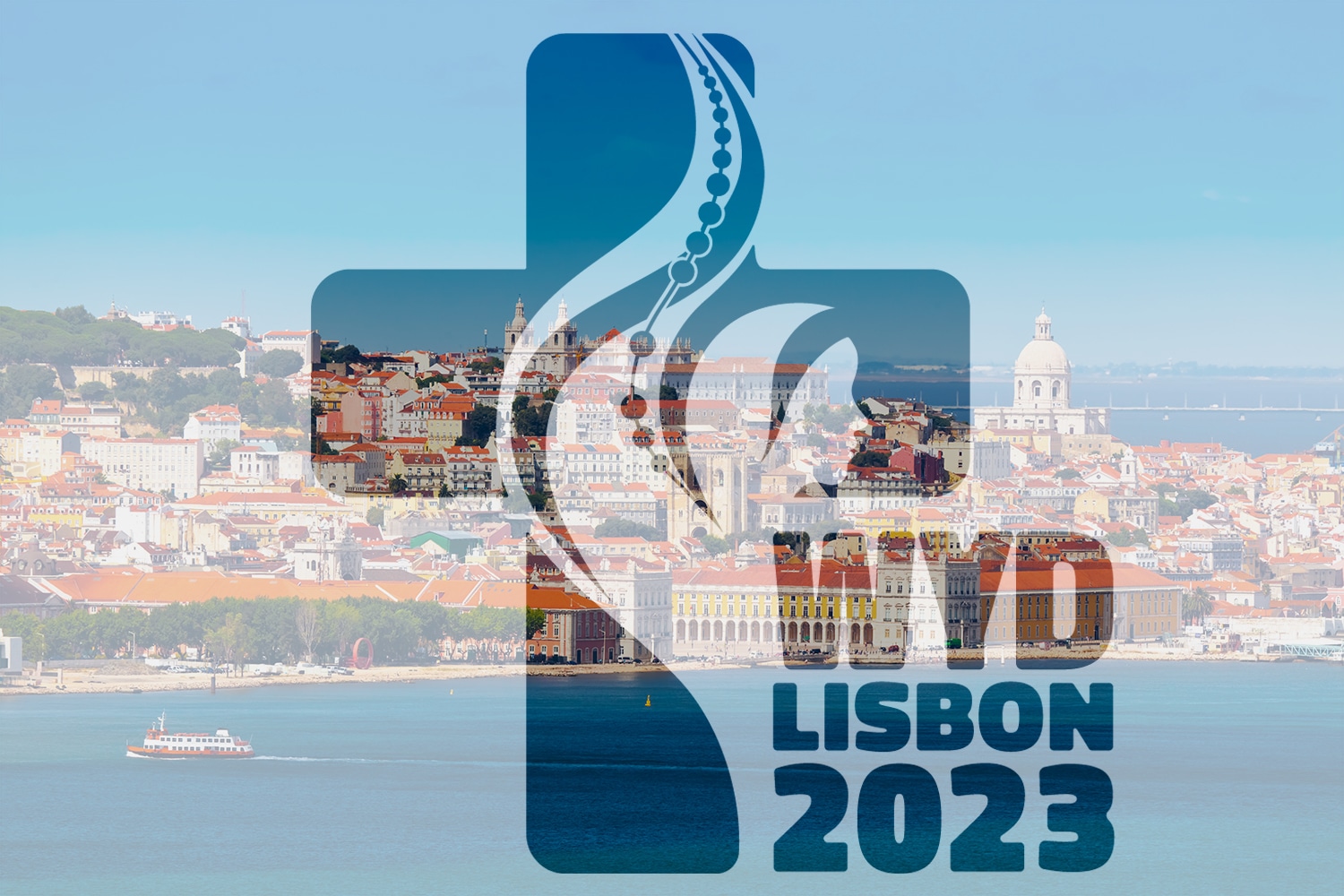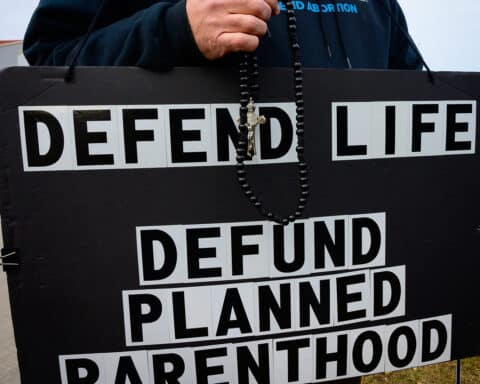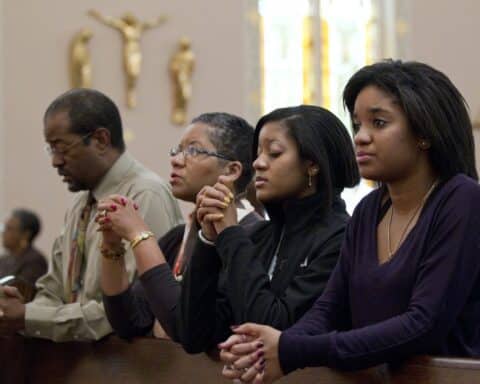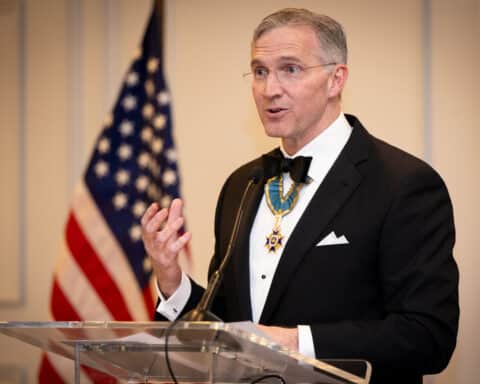KRAKOW, Poland (OSV News) — One issue involving World Youth Day perpetually makes headlines months before the event: that of costs. The event taking place Aug. 1-6, 2023, in Lisbon, Portugal, is no exception.
As reported by Reuters, Lisbon’s mayor, Carlos Moedas, was sharply criticized on Portuguese social media after it was revealed his office would spend over $5.4 million (5 million euros) to build a 54,000-square foot altar for the final Mass of the August event.
“The specifications for the stage were defined in meetings we had with World Youth Day, the Church and the Holy See,” Moedas told reporters, including Reuters, while also acknowledging it was a “very expensive” project.
The Vatican answered immediately saying the final decision corresponds to local authorities. In a statement to Aciprensa news agency, Vatican press office director Matteo Bruni explained that “the organization of the event is decided locally.”
The expensive altar is not the only aspect that created controversy. In October, the Portuguese government announced that public institutions would spend around $190 million in WYD. On Jan. 31, after the uproar about the altar, the government led by socialist prime minister António Costa announced a reduction of the initial figure.
It’s like planning the Olympics
But are these costs as astronomical as they seem? World Youth Day is a major international event of the Catholic Church, one that brings together millions of young people from around the world to pray, learn and meet with the current pope for a handful of days every few years.
Begun by St. John Paul II, known lovingly as the “pope of the youth,” the first WYD was in Rome in 1986 and drew 300,000 people. Less than 10 years later, the final Mass of WYD in Manila, Philippines, gathered 4 million people, as estimated at the time by The New York Times. Three million youth flooded Copacabana Beach in Rio de Janeiro in 2013 for the final Mass with Pope Francis, and an estimated 2 million gathered in Krakow in 2016.
“It is a beautiful event,” Weronika Grishel, a member of the WYD Organizing Committee in Krakow, told OSV News. “I participated in four World Youth Days — in Cologne, Madrid, Rio and Krakow — and I can tell you it was a transforming experience for me, magnifying my faith, bringing joy to my life, creating friendships I cherish for years.”
It is, however, “a costly one.”
Planning WYD is “like organizing the Olympics, only with a bigger audience and one absolutely important VIP guest,” she said.
Consider WYD Krakow
There were two main altars in Krakow, one at Blonia Park, close to the city center, and the other at Campus Misericordiae (the Field of Mercy), where the final Mass took place. According to the financial report presented in December 2016 by the WYD Organizing Committee, the total cost of the venue in Blonia Park, including not only the altar but organizational expenses of three live events and a reconciliation zone with confessionals, cost $5.5 million (the cost of just the altar in Lisbon), and the latter venue in total, including the altar and organization of a Saturday vigil and final Mass, was $8.6 million.
“You have to provide security — utmost priority — for the people standing at the altar; it can’t be provisional,” Grishel added, emphasizing that some expect the Church to organize a full-scale event featuring one of the most famous individuals in the world — the pope — for little to no cost.
“World Youth Day committees organize a religious event, yes, but it is a professional event as well, where hundreds of professional musicians perform, where hundreds of people are seated for Mass, where huge technical background is needed, including sound and TV camera systems,” she said. “This costs, and they can’t do it for nothing.”
Public investment in religious events?
Controversies in Europe regarding public investment in religious events are frequent. WYD Madrid organizers foresaw those tensions and made the decision not to accept any public money. Instead, they would do a scaled-down event with a budget of $54.4 million (half of the cost of the event in Rio de Janeiro, which left the archdiocese in debt) and launched an effective sponsorship program. Spanish companies provided $18.8 million for the event.
“In order to ensure a peaceful and constructive environment around WYD, it is crucial to be transparent in every aspect of the organization, to organize open bidding processes that grant real competition,” Yago de la Cierva, WYD 2011 executive director, told OSV News, adding that being prudent regarding costs always helps. “Church events should also be accountable.”
The good news is that Lisbon may actually end up coming out ahead on WDY. At least this is what happened in Madrid. Local organizers entrusted PriceWaterhouseCoopers, one of the big consultancy global firms, with a report of the event’s economic impact in Spain. The report showed a positive impact of $256 million on the Madrid economy and over $100 million more in the country, plus $29 million more in tax collection.
Because Portugal is in Europe, it realistically could attract a similar number of tourists and pilgrims as Madrid and Krakow.
Krakow WYD’s total cost was $46 million, and the Polish state provided $4.4 million to the organizers.
Where does the money come from?
Most of the revenue from any WYD comes from participant registration fees. Everyone can participate for free, but a modest registration fee, considered the youths’ contribution to their own event, is required. In Krakow, registration fees were calculated as 81% of the budget. According to the Krakow University of Economics, pilgrims — who also are tourists — left $116 million in the city. An additional $7.4 million was paid by the WYD Organizing Committee in taxes to the state.
“I remember protests in the media and among Polish citizens (asking) how come we can finance the Church event from our taxes? But the truth is, the event was a huge financial success both for the state and local municipality,” Father Piotr Studnicki, who was spokesman for the Archdiocese of Krakow in 2016, told OSV News. “The benefits and the promotional advantage of organizing such an event are even bigger.”
“Krakow’s researchers counted that the city of Krakow would have to invest $127 million in advertisement to have such visibility in the foreign media as they had during those days when Pope Francis was in Krakow,” he added.
Father Studnicki strongly underlined that full transparency is needed along the way. “You can’t play hide and seek with the media. The event is costly, yes, but it has amazing advantages, and the more transparent you are, the more down to earth, the better not only for you, but for the event, which is meant to be a feast of joy and unity, not divisions,” he said.
Paulina Guzik is international editor for OSV News.





